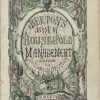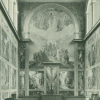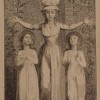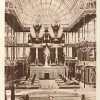
Erik Simpson, “On Corinne, Or Italy”
Germaine de Staël’s Corinne, Or Italy was published in French in 1807 and was quickly translated into English. It became a touchstone for nineteenth-century conceptions of women’s creativity and the life of the woman writer, as well as an important formulation of analogies between models of artistic creation and political systems. The novel’s portrayal of Italian improvisers also helped produce the modern usage of “improvisation” and related terms in English.

Herbert F. Tucker, “In the Event of a Second Reform”
Between the 1867 passage of the Second Reform Bill and that of the Forster Education Bill in 1870, Britain undertook its modern metamorphosis into an effectively secular and democratic state, in a legislative process concurrently abetted and assessed by contemporary productions in literature. Thick description of this process illustrates by example this entry’s framing questions about the nature and the scale of an “event.”

Christopher Lane, “On the Victorian Afterlife of the 1781 Sunday Observance Act”
Proposed in 1780 to “suppress” the rise of Dissenting and freethinking societies, the Sunday Observance Act was passed in 1781 and adopted across Britain that year. In seeking to encourage Sunday worship, the new law aimed to curb Sunday trading and to prevent the public on such days from visiting parks, museums, zoos, theaters, meeting-houses, and concert halls. The interest of this essay lies in the cultural effects of such legislation, as well as in the figure who proposed it, Bishop Beilby Porteus, and the freethinking philosopher, William Nicholson, who is said to have challenged Porteus and Britain’s episcopacy by detailing the law’s and the Bible’s inconsistencies. The pamphlet attributed to Nicholson, though its authorship remains contested, is called The Doubts of Infidels.

Susan Zlotnick, “On the Publication of Isabella Beeton’s Book of Household Management, 1861″
This essay examines Isabella Beeton’s Book of Household Management, which has been called “the most famous English cookery book ever published.” It contends that Beeton’s work shares the same concerns as the nineteenth-century realist novel, and that The Book of Household Management captures the contradictions, anxieties, aspirations and fantasies of middle-class domesticity and thereby offers a vision of family life that is novelistic in its complexity. Specifically, the essay focuses on Beeton’s representation of the middle-class housewife as a domestic manager responsible for maintaining the family’s class identity by creating a “tasteful” lifestyle. In doing so, it concludes that the line from the Victorian Mrs. Beeton to the Martha Stewarts of our own day is a fairly direct one.

Stephanie Kuduk Weiner, “On the Publication of John Clare’s The Rural Muse, 1835″
This entry places John Clare’s book The Rural Muse in the context of the publishing landscape of 1835. Tracing the publication history of two poems that appeared in that volume as well as in the periodical press and in literary annuals, “A Spring Morning” and “The Nightingale’s Nest,” Weiner shows how attending to the modes and formats of print publication illuminates thematic and formal aspects of Clare’s poems. Clare’s approach to the sonnet, his treatment of nature, and his concept of the book are examined.

Dane Kennedy, “The Search for the Nile”
This essay examines the social and cultural contexts that informed British explorers’ efforts to discover the source of the Nile. It highlights the relationship of these expeditions to existing systems of trade and power in East Africa, British imperial interests in the region, and the development of a celebrity culture in Britain.

Margaretta S. Frederick, “On Frederic Shields’ Chapel of the Ascension, 1887-1910”
On 26 February 1911, the Pre-Raphaelite artist Frederic Shields (born 1833) died, having spent the last twenty years of his life devoted to the decoration of the Chapel of the Ascension in Bayswater, London. Conceived of in 1887, completed in 1910, bombed in 1944 during the Blitz of World War II and demolished in 1969, the Chapel represents changing Victorian precepts of religion and faith as well as attitudes towards public art and decoration on the eve of the modern age. Designed by the architect and aesthete Herbert Horne (1864-¬1916) and modeled on thirteenth-century northern Italian church architecture, the chapel design was a reflection of the British rediscovery of the Italian Renaissance during the Victorian period. Shields’ use of the marouflage technique, mimicking continental fresco schemes, reflects a national desire to raise public British art to a level of “high art,” which would ensure it a place in the art historical canon.

Ghislaine McDayter, “On the Publication of William Godwin’s Memoirs of the Author of A Vindication of the Rights of Woman, 1798″
William Godwin’s publication of Mary Wollstonecraft’s memoirs in 1798 had a massive impact on Wollstonecraft’s posthumous reputation and literary legacy. While Godwin’s refusal to finesse an increasingly conservative readership by downplaying his wife’s sexual independence in the Memoirs may have initiated a violent rejection of Wollstonecraft’s work for nearly a century, it also highlighted the important political radicalism of her work that might otherwise have been forgotten.

Anne Helmreich, “On the Opening of the Crystal Palace at Sydenham, 1854”
The Crystal Palace at Sydenham represents a number of key paradigms in Victorian culture: the emphasis upon visuality as a means of acquiring and conveying knowledge, the use of display as a vehicle of both education and entertainment, the desire to construct unifying historical narratives, and the emphasis upon rational recreation.

Nicholas Frankel, “On the Whistler-Ruskin Trial, 1878”
In 1877 the painter James McNeill Whistler initiated an action for libel against the critic John Ruskin, who had defamed Whistler and his paintings in print. The legal outcome of the resulting trial—a technical verdict for Whistler, but with damages of just one farthing and no award of costs—satisfied nobody and represents a turning point in the principal antagonists’ lives. As importantly, it heralded a reconfiguration in the respective positions of the critic and the artist, if not a reconceptualization of the very meaning of these terms. The trial exposed to scrutiny the spiritualizing mission of criticism itself while bringing about an elevation and expansion of the concept of the artist. As Shearer West has argued, it also offered an important precedent for the power of laughter and wit to demolish the self-representations of established power.
